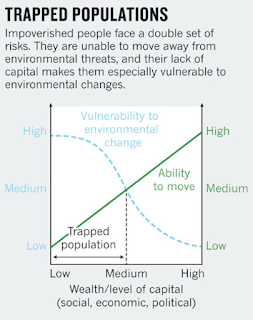Motivated by the recent devastating flooding in the North of England, I wanted to briefly explore potential
mitigation mechanisms. With sea level increasing, and 650 million people projected to be at risk from storm surges by
2100, attention towards this area will become ever more critical. I have
previously discussed the pros and cons of migration in offering one such
mitigation mechanism for these changes, but this drastic ‘worst case scenario’
solution is by no means the only option.
The IPCC proposed three strategies for
flood protection in their first assessment; protection, accommodation and retreat. Protection refers to the typical hard engineering
methods, such as breakwaters and sea defences. Accommodation describes a possible change in land
use of areas within a coastal zone. This may dictate a change in agricultural
habits, such as converting rice paddies to fish reservoirs, or changes to
housing design. Retreat would
regulate land use in areas considered to be vulnerable. These basic ideas have
since been further developed and are represented in the diagram below.
 |
|
Developed of the IPCC coastal
adaptation strategy, from The
Japan Academy (2013)
|
The latter solution has received
recent support from Temmerman and Kirwan (2015), who
recommends an ecosystem approach to coastal defence. It highlights the
vulnerability of countries situated within vast river deltas, such as Bangkok,
Shanghai and New York, to extreme flood events. They say that hard engineering
approaches in these environments will become less plausible in the future due
to inevitable energy price increases. Additionally, they interrupt natural
delta processes, which may actually increase long term flood risk. Instead they
propose that ecosystem-based engineering will provide much greater protection,
with the restoration and retention of wetland environments enabling further
natural land building processes. Projects of this nature have recently begun in
Mississippi and the Rhine-Meuse delta. Depending on their success, more
countries may look towards implementing this style of long term mitigation
strategy.
The Pacific islands are even more
vulnerable to rising sea levels and Anote Tong, the President of Kiribati, has
recently been voicing his suggestions on how this risk could be managed. As I
have mentioned previously, Kiribati are considering the role of migration
within their adaptation strategy, but are also determined to maintain the
island nation as a habitable entity. In his article,
Tong suggests the country relocates to large floating islands, anchored to the
sea. These would supposedly be able to support a population of 30,000 for a
century. With reference to his slightly unusual idea, he says:
"It's radical, unprecedented, way out of the box, but in
the absence of other options, unless you can come up with alternatives, I'm
afraid that these are the options available to us."
Whilst this idea is no doubt unique,
Tong raises an important point. The conditions we are predicted to face in the
next century are unprecedented, and our current methods of adaption and mitigation
may be insufficient to deal with this threat. Consequently, there is a constant
demand for new and innovative ideas to reduce vulnerability to these threats
which could offer a significant investment opportunity to those in the
engineering industry.

